Can Dogs Eat Apples? 3 Amazing Health Benefits of Apples for Dogs
As pet owners, we often find ourselves wondering about the safety of human foods for our furry companions. One such question that frequently arises is, “Can dogs eat apples?” Apples are known for their nutritional benefits in humans, but are they equally beneficial for dogs? Let’s delve into the details of this crunchy fruit and understand its impact on your dog’s health.
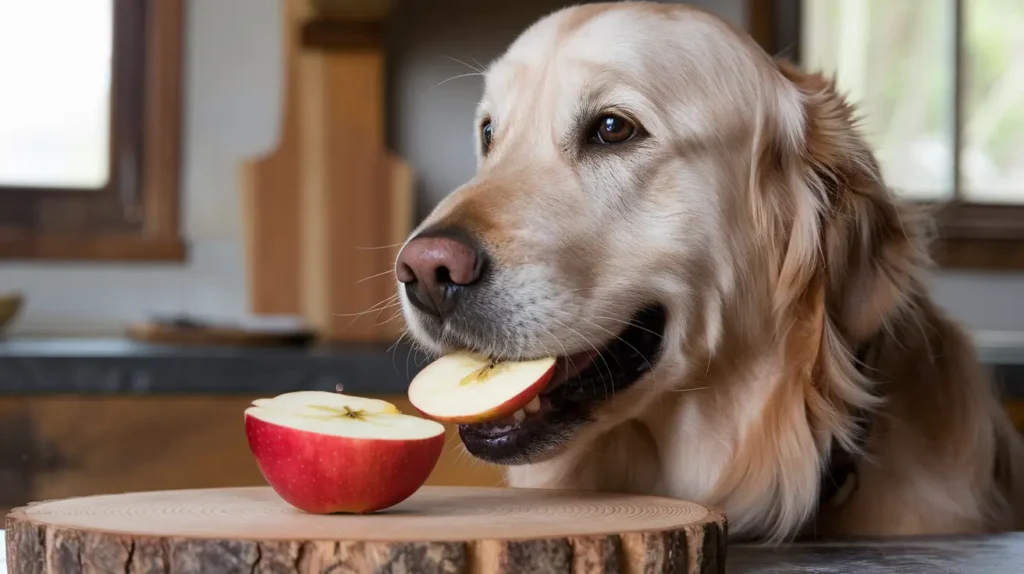
Table of Contents
Are Apples Safe for Dogs?
The short answer is yes, apples are safe for dogs to eat in moderation. Apples can be a healthy and refreshing snack for your dog, provided certain precautions are taken. Rich in vitamins and antioxidants, apples offer numerous benefits for dogs. However, not all parts of the apple are safe for consumption. Let’s break down the components:
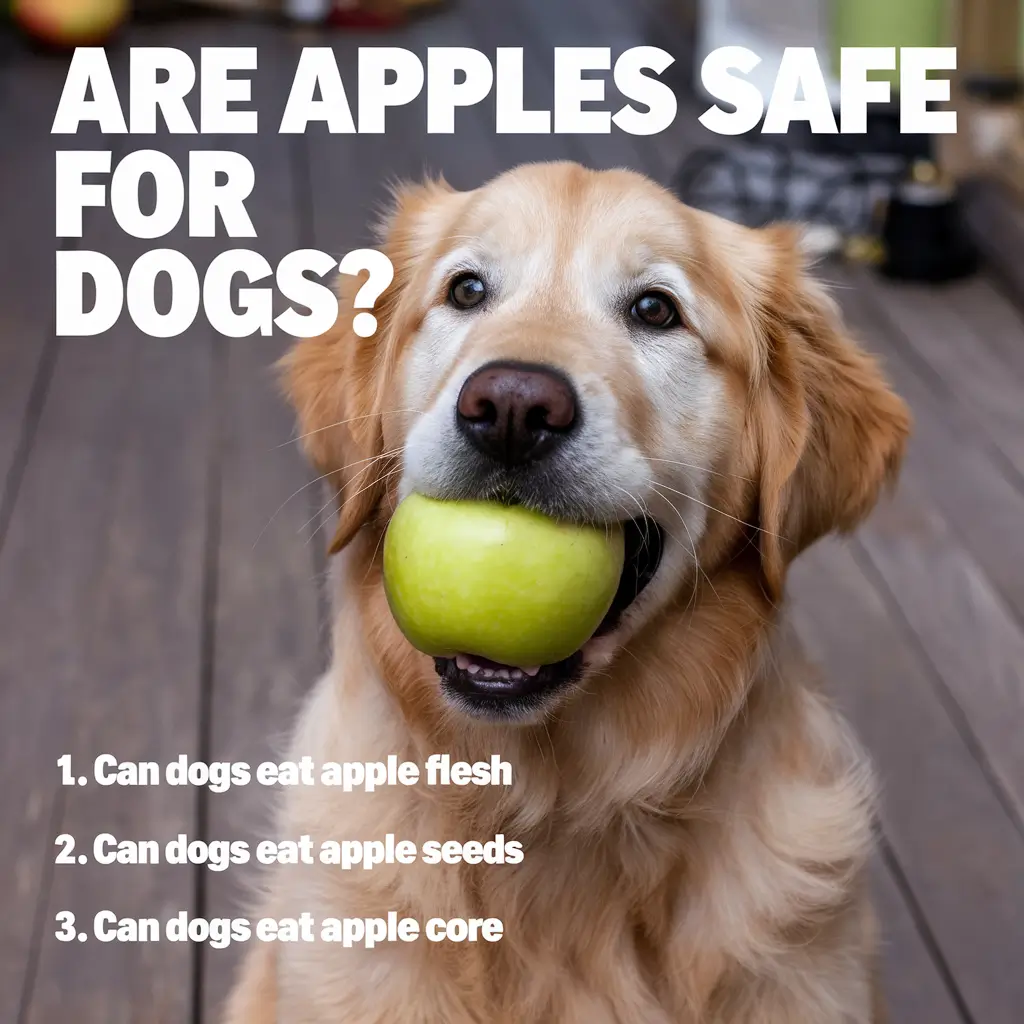
Can Dogs Eat Apple Flesh: The flesh of the apple is packed with nutrients and is generally safe for dogs.
Can Dogs Eat Apple Seeds: Apple seeds contain cyanide, a toxin that is harmful to dogs when ingested in large quantities.
Can Dogs Eat Apple Core: The core can pose a choking hazard, especially for smaller dogs.
When given appropriately, apples can be a beneficial addition to your dog’s diet. Let’s explore the health benefits in more detail.
Health Benefits of Apples for Dogs
Apples are nutrient-dense and can contribute positively to your dog’s health when provided in moderation. Here are some key benefits:
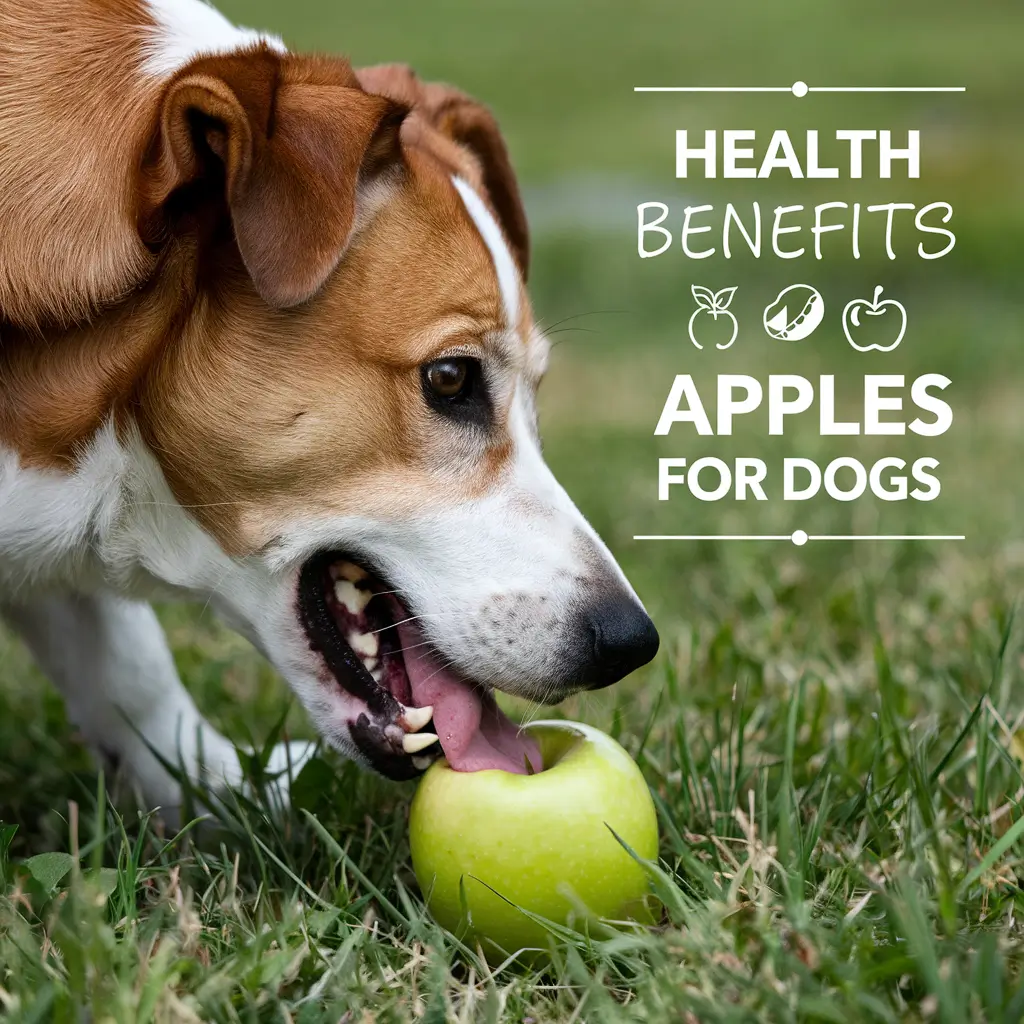
- 1. Rich in Essential Nutrients
Apples are a great source of vitamins such as:
- Vitamin A: Supports vision health, promotes skin and coat health, and strengthens the immune system.
- Vitamin C: Helps in maintaining a robust immune system and is beneficial for elderly dogs.
- Vitamin K: Assists in blood clotting and bone health.
Additionally, apples are high in dietary fiber, which aids in digestion and promotes regular bowel movements.
2. Low in Calories
One of the appealing aspects of apples is their low-calorie content. They make an ideal treat for overweight dogs or those prone to obesity. Replacing traditional treats with apples can help control calorie intake, contributing to a healthier weight.
3. Packed with Antioxidants
The antioxidants in apples can help combat free radicals, supporting cellular health and potentially reducing the risk of certain diseases. This benefit can be particularly advantageous for aging dogs or those predisposed to conditions like cancer.
Can Dogs Eat Apple Peels?
Yes, apple peels are generally safe for dogs to consume. However, they can be difficult to digest for some dogs, especially those with sensitive stomachs. If your dog experiences gastrointestinal upset, it might be better to peel the apple before serving.
Can Dog Eat Apple Sauce?
Yes, dogs can eat applesauce, but there are a few important considerations before including it in their diet.
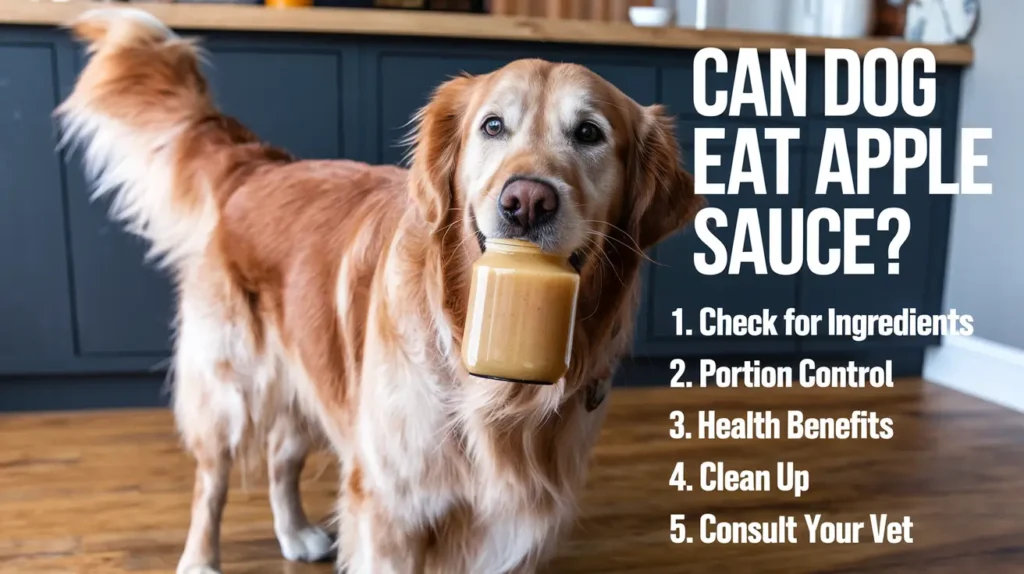
1. Check for Ingredients
- Unsweetened Applesauce: The best option for dogs is unsweetened applesauce, which contains only pureed apples. Sweetened varieties often contain added sugars, which can lead to obesity, dental problems, and other health issues in dogs.
- Avoid Harmful Additives: Some applesauce brands may include ingredients like artificial sweeteners (such as xylitol), preservatives, or spices like cinnamon, which can be harmful to dogs. Always read the label carefully to ensure that the applesauce is free from harmful ingredients.
2. Portion Control
Small Servings: Start by offering a small spoonful of applesauce and monitor your dog for any signs of digestive upset, such as vomiting or diarrhea.
Moderation is Key: Applesauce should be given as an occasional treat and not a regular part of your dog’s diet. While apples are a healthy fruit, applesauce is more concentrated and lacks the fiber present in fresh apples, meaning it can raise your dog’s blood sugar levels if given in large amounts.
3. Health Benefits
- Vitamins and Nutrients: Applesauce can provide your dog with beneficial nutrients such as vitamins A and C, as well as antioxidants, which support a healthy immune system.
- Easier to Digest: For dogs with dental issues or older dogs that have trouble chewing solid food, applesauce can be a soft and easy-to-digest treat.
4. Avoid Sugar-Free Varieties with Xylitol
- Toxic Sweeteners: Some sugar-free applesauce may contain xylitol, a sweetener that is highly toxic to dogs, even in small amounts. Xylitol can cause a rapid insulin release in dogs, leading to dangerously low blood sugar (hypoglycemia), liver failure, or even death. Always check the ingredient list to ensure there is no xylitol.
5. Consult Your Vet
- If your dog has health conditions like diabetes or obesity, consult your veterinarian before giving them applesauce, as the natural sugars in apples may affect their condition.
Can Dogs Eat Apple Slices?
Yes, dogs can safely eat apple slices as long as certain precautions are taken. Apple slices can be a healthy treat for dogs, providing fiber, vitamins A and C, and antioxidants that support overall health. However, it’s important to:
- Remove the Core and Seeds: Apple seeds contain cyanide, which is toxic in larger quantities, and the core can be a choking hazard or cause digestive blockage.
- Introduce Slowly: If it’s your dog’s first time eating apples, introduce small amounts to ensure they tolerate it well without any digestive issues like diarrhea or upset stomach.
Benefits:
- Good source of hydration and low in calories.
- Helps clean teeth by acting as a natural scrub.
Can Dogs Eat Apple Pie?
No, apple pie is not recommended for dogs. While the apples in the pie may be safe, the additional ingredients typically found in apple pie, such as sugar, butter, spices (especially nutmeg), and pastry, can be harmful to dogs. Here’s why:
- Sugar: High sugar content in apple pie can contribute to obesity, diabetes, and dental problems in dogs.
- Nutmeg: Nutmeg, often used in apple pie, contains myristicin, a compound that can cause toxicity in dogs, leading to symptoms like tremors, disorientation, and seizures.
- Butter and Fats: The rich, fatty content in the pie’s crust can upset your dog’s stomach, potentially leading to pancreatitis if consumed in large amounts.

Can Dogs Eat Apple Pear?
Yes, dogs can eat apple pear (Asian pear), but as with apples, certain precautions must be taken:
- Moderation: Apple pears, like other fruits, contain natural sugars. It’s important to give them in moderation to avoid any blood sugar spikes, especially in dogs with diabetes.
- Remove Seeds and Core: Just like apples, apple pears also have seeds that contain cyanogenic glycosides, which can release cyanide if consumed in large amounts. Make sure to remove the seeds and core before offering them to your dog.
Benefits:
The high water content in apple pears can help keep your dog hydrated.
Apple pears are rich in fiber, vitamins, and antioxidants, which support digestive health and boost the immune system.
Can Dog Eat Apple Skin?
Yes, dogs can eat apple skin, but there are a few important considerations to keep in mind. Here’s a step-by-step guide to help you decide if apple skin is suitable for your dog:
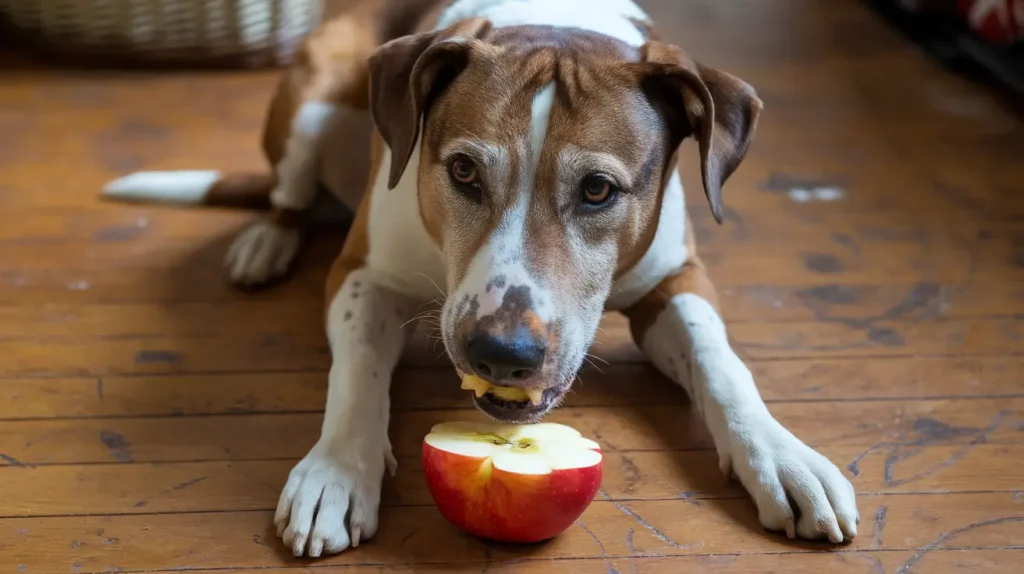
1. Determine if Your Dog Can Tolerate Apple Skin
- Apple Skin Nutrition: Apple skin contains beneficial nutrients like fiber, antioxidants, and vitamins A and C, which can support your dog’s overall health. However, it also contains a higher concentration of fiber than the flesh, which could upset some dogs’ stomachs.
- Dog’s Digestive Sensitivity: If your dog has a sensitive stomach or has never eaten apples before, start by offering a small amount of peeled apple and gradually introduce the skin in small quantities to see how they react.
2. Wash the Apple Thoroughly
- Remove Pesticides: Apple skin can carry pesticides or wax coatings, which could be harmful to dogs. Wash the apple thoroughly with water or use a dog-safe fruit and vegetable wash to remove any residues.
3. Slice the Apple Into Small Pieces
- Avoid Choking Hazards: Cut the apple into bite-sized pieces to make it easier for your dog to chew and digest. This also reduces the risk of choking, especially for smaller dogs.
4. Remove the Core and Seeds
- Toxicity of Seeds: Apple seeds contain small amounts of cyanogenic compounds, which release cyanide. While a few seeds are unlikely to cause immediate harm, it’s safer to remove the seeds completely before offering apple slices to your dog.
- Core Blockage Risk: The apple core can be difficult for dogs to chew and digest and may cause an intestinal blockage, so it’s important to remove the core before feeding.
5. Monitor Your Dog After Eating
- Check for Signs of Digestive Issues: After feeding your dog apple skin, monitor them for any signs of discomfort, such as vomiting, diarrhea, or gas. If your dog experiences any negative symptoms, it’s best to avoid giving them apple skin in the future.
6. Adjust Portion Size Based on Your Dog’s Size
- Small Dogs: For smaller dogs, give just a few pieces of apple with skin, as their digestive systems may be more sensitive to the higher fiber content.
- Larger Dogs: Larger dogs may tolerate more apple skin, but it’s still best to limit the portion to a few slices at a time.
7. Consult a Vet if Necessary
- Consult Your Vet: If your dog has any pre-existing health conditions, such as digestive issues, diabetes, or allergies, consult your vet before introducing apples or apple skin into their diet.
Can Dogs Eat Apples? What American Medical Universities and Pet Labs Say
According to research from American medical universities and veterinary sources, apples can be a healthy snack for dogs when given in moderation. Experts from Tufts University and other veterinary clinics emphasize that apples are rich in fiber, vitamins A and C, and antioxidants, which can contribute to your dog’s overall health.
Cummings School of Veterinary Medicine
However, they also warn about certain risks, particularly when it comes to apple seeds and cores, which contain cyanide-like compounds and should be avoided
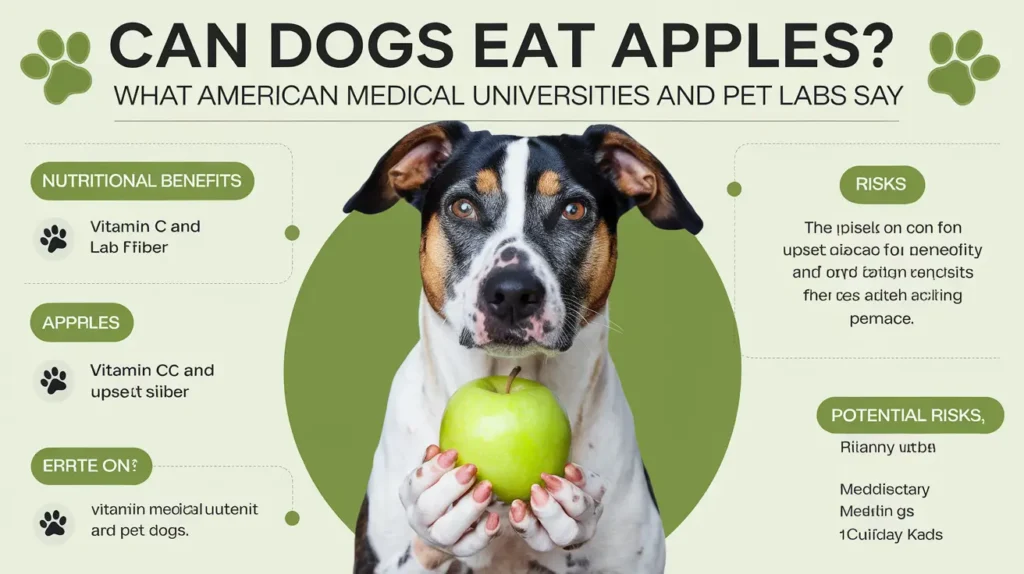
Veterinary research confirms that apples can be a beneficial, low-calorie treat for dogs, promoting dental health and offering a refreshing alternative to processed dog snacks
Still, owners should be cautious with portions, as too much fruit can cause digestive issues due to its fiber content
How to Safely Serve Apples to Your Dog
To ensure that your dog enjoys apples safely, follow these preparation steps:

- Introduce Slowly: If it’s your dog’s first time eating apples, introduce them gradually to monitor for any adverse reactions.
- Wash the Apple: Clean the apple thoroughly to remove any pesticide residue.
- Slice into Small Pieces: Cut the apple into bite-sized pieces that are easy for your dog to chew and digest.
- Remove the Core and Seeds: Always remove the core and seeds to prevent choking and potential cyanide poisoning.
Potential Risks of Feeding Apples to Dogs
While apples offer multiple benefits, it’s essential to exercise caution due to potential risks:
1. Cyanide in Apple Seeds
Apple seeds contain amygdalin, a compound that releases cyanide when metabolized. Even though small amounts may not pose an immediate threat, repeated ingestion can accumulate cyanide in the dog’s system, leading to toxicity. Always remove the seeds before offering apples to your pet.
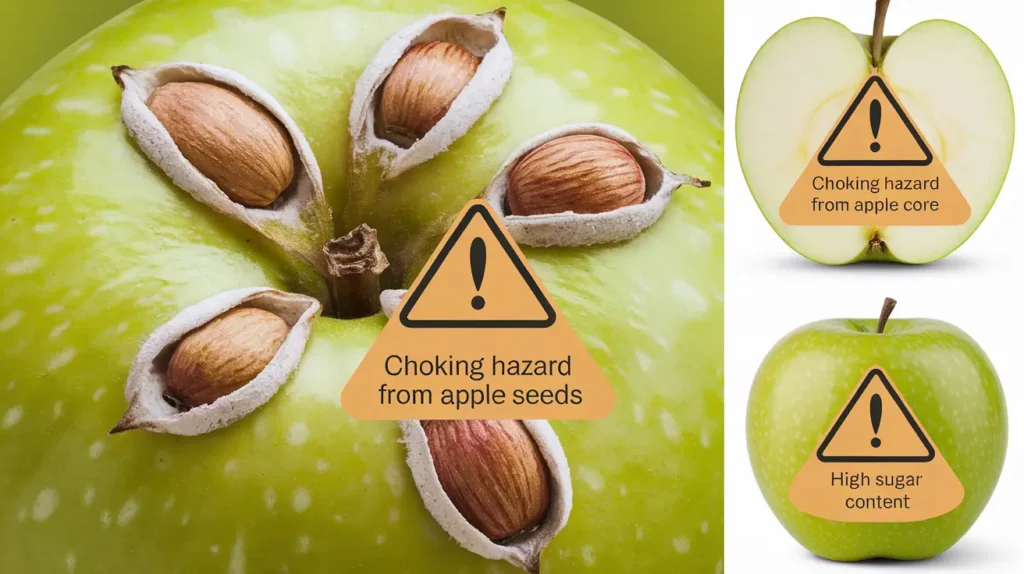
2. Choking Hazard from Apple Core: The apple core is tough and can become a choking hazard, especially for small or medium-sized dogs. To avoid this, it’s best to slice the apple and remove the core entirely.
3. High Sugar Content: Apples contain natural sugars, and although they are healthier than artificial sweeteners, excessive sugar intake can lead to weight gain and dental issues. It’s crucial to limit apple servings, particularly for dogs with diabetes.
Alternatives to Apples for Dogs
If your dog doesn’t enjoy apples or if you’re looking to diversify their fruit treats, there are several other safe and nutritious alternatives. Here are a few excellent fruit options that can provide similar benefits without causing harm:
1. Blueberries
- Nutritional Benefits: Blueberries are a superfood for dogs, rich in antioxidants, fiber, and vitamins C and K. These nutrients help support the immune system, reduce inflammation, and promote overall health.
- Serving Suggestions: Blueberries can be given fresh or frozen as a low-calorie treat. You can offer them one at a time or mix them into your dog’s regular food. Their small size makes them perfect for training rewards.
- Why Blueberries?: They are low in sugar and easy on the stomach, making them an excellent alternative for dogs that are sensitive to fruits with higher sugar content, like apples.
2. Bananas
- Nutritional Benefits: Bananas are packed with potassium, fiber, and vitamins B6 and C. Potassium is essential for heart and kidney function, while fiber aids digestion.
- Serving Suggestions: While bananas are beneficial, they should be served in moderation due to their high sugar content. Offering a few small slices or mashing them into your dog’s food is a safe way to include bananas in their diet.
- Why Bananas?: They are a good source of energy and can be particularly helpful for active or older dogs that need a little boost. They also work as a treat that’s easy to mash or freeze for cooling snacks in warmer weather.
3. Watermelon (Seedless)
- Nutritional Benefits: Watermelon is a hydrating fruit, as it contains about 92% water, making it a perfect treat on hot days. It’s also low in calories and contains vitamins A, B6, and C, which help support vision and immune health.
- Serving Suggestions: Make sure to remove all seeds and the rind before feeding watermelon to your dog, as these parts can be choking hazards or difficult to digest. Offer small, bite-sized cubes for a refreshing snack.
- Why Watermelon?: It’s not only delicious but also a great option for overweight dogs or those needing to stay hydrated, especially during the summer. It’s a guilt-free, hydrating treat that can be given more often than higher-sugar fruits.
4. Strawberries
- Nutritional Benefits: Strawberries are another antioxidant-rich fruit that can help boost your dog’s immune system. They are also high in fiber, which supports digestion, and contain enzymes that can help whiten your dog’s teeth naturally.
- Serving Suggestions: Fresh strawberries, cut into small pieces, can be a great treat. Avoid canned or processed strawberries that often contain added sugar.
- Why Strawberries?: The fiber content in strawberries aids digestion, and the natural sweetness makes them appealing to most dogs. They are also lower in calories compared to some other fruits.
5. Pineapple (in Moderation)
- Nutritional Benefits: Pineapples are rich in vitamin C, manganese, and other essential vitamins and minerals. They also contain bromelain, an enzyme that aids protein digestion.
- Serving Suggestions: Fresh pineapple, peeled and cut into small pieces, can be given as an occasional treat. Avoid canned pineapple, which often has added sugars.
- Why Pineapple?: While not as commonly given, pineapple can be a tasty alternative for dogs that enjoy a sweet, juicy fruit. Its enzymes can promote healthy digestion, making it a good treat for dogs with occasional digestive issues.
Important Considerations for All Fruits:
Remove Harmful Parts: Always remove seeds, pits, and rinds from fruits, as these can pose choking hazards or contain harmful substances.

Portion Control: Even though these fruits are healthy, it’s crucial to feed them in moderation. Too much fruit can cause digestive upset or diarrhea due to the high fiber and sugar content.
Gradual Introduction: When introducing any new fruit to your dog’s diet, do so gradually. Start with small amounts to ensure they tolerate it well and monitor for any signs of allergies or digestive problems.
Fruits to Avoid
While many fruits are safe for dogs, there are certain fruits that should be avoided because they can be toxic or cause serious health issues. Here’s a deeper look at the fruits to avoid and why they are dangerous for dogs:
1. Grapes and Raisins
- Toxicity: Grapes and raisins (dried grapes) are highly toxic to dogs and can lead to acute kidney failure. The exact cause of the toxicity is not fully understood, but even a small amount can be dangerous for some dogs. Symptoms may include vomiting, diarrhea, lethargy, and lack of appetite. If not treated promptly, ingestion of grapes or raisins can result in kidney damage, which can be fatal.
- Symptoms of Poisoning: Within a few hours of consumption, a dog may start vomiting or displaying signs of stomach discomfort. Over the next 24 hours, more serious symptoms, such as increased thirst, decreased urination, and lethargy, may occur, signaling kidney damage.
- Immediate Action: If you suspect your dog has eaten grapes or raisins, seek veterinary help immediately. Inducing vomiting and providing treatment as soon as possible can prevent severe damage.
2. Cherries
- Toxic Parts: The flesh of the cherry itself is generally safe in small amounts, but the pit, stem, and leaves contain cyanogenic compounds, which are toxic. If ingested, cyanide can interfere with the body’s ability to carry oxygen, potentially leading to respiratory failure.
- Symptoms of Cyanide Poisoning: Symptoms include difficulty breathing, bright red gums, dilated pupils, and shock. In severe cases, it can lead to death if left untreated.
- Choking Hazard: In addition to cyanide risk, the cherry pit is also a choking hazard and can cause gastrointestinal blockages if swallowed.
3. Citrus Fruits (in Large Quantities)
- Potential Harm: While small amounts of citrus fruits like oranges, lemons, or limes may not harm your dog, larger quantities can lead to gastrointestinal upset. Citrus fruits contain citric acid and essential oils, which can cause irritation in a dog’s digestive system. The peels, seeds, and plant material are especially concentrated with these compounds and should be avoided entirely.
- Symptoms: Dogs that consume too much citrus may experience vomiting, diarrhea, drooling, or trembling. In severe cases, the essential oils in citrus peels can depress the central nervous system and lead to more serious problems.
- Moderation: If you give your dog a small piece of orange as an occasional treat, remove the seeds and peel to minimize the risk of digestive upset.
4. Persimmons
- Toxic Part: The flesh of persimmons is not toxic, but the seeds and pits can cause intestinal obstructions, especially in smaller dogs. Additionally, the seeds can cause inflammation of the intestines (enteritis).
- Symptoms: Dogs that ingest persimmon seeds may experience vomiting, abdominal pain, and diarrhea. In severe cases, an intestinal blockage may require surgical intervention.
5. Avocados
- Toxic Compound: Avocados contain a toxin called persin, which can cause vomiting, diarrhea, and heart congestion in dogs if consumed in large quantities. While the flesh contains a lower concentration of persin, the pit, skin, and leaves have higher amounts and are dangerous.
- Choking Hazard: The avocado pit can also pose a significant choking hazard and can cause an intestinal blockage if swallowed.
- Symptoms: Ingestion of avocado may cause mild stomach upset in some dogs, but severe reactions can involve more serious gastrointestinal or respiratory issues, especially if larger amounts or the pit are consumed.
Why These Fruits Are Harmful:
- Cyanogenic Compounds: Fruits like cherries contain compounds that can release cyanide, a poison that prevents cells from getting enough oxygen.
- Kidney Failure: Grapes and raisins can cause sudden and severe kidney damage, even in small quantities.
- Gastrointestinal Distress: Citrus fruits, when consumed in large amounts, can irritate the dog’s digestive system due to their acidity and essential oils.
- Choking Hazards and Obstruction Risks: Pits and seeds from various fruits can become lodged in a dog’s throat or digestive tract, potentially causing blockages that require surgical intervention.
How Much Apple Should You Feed Your Dog?
When feeding your dog apples, the right portion size is key to ensuring they enjoy the health benefits without experiencing any digestive issues. Here’s a deeper look into how much apple you should give your dog based on their size, age, and health needs:
Portion Guidelines by Dog Size:
Small Dogs (up to 20 lbs): Small breeds like Chihuahuas or Dachshunds should receive 1-2 small apple slices or a few small cubes at a time. For these dogs, apples should be treated as an occasional snack rather than a daily treat due to their size and calorie needs.
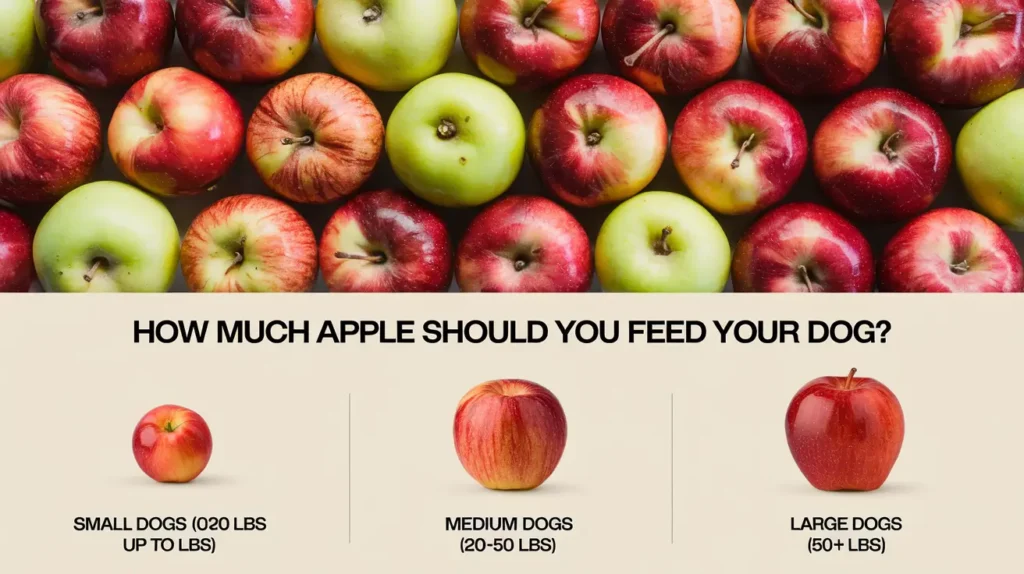
Medium Dogs (20-50 lbs): Medium-sized dogs, such as Beagles or Cocker Spaniels, can handle slightly larger portions. Half of an apple, sliced into manageable pieces, can be given as a snack once or twice a week. However, avoid giving them the core or seeds.
Large Dogs (50+ lbs): Large breeds, such as Labradors or German Shepherds, can eat up to a whole apple sliced into smaller pieces, but only occasionally. For large dogs, apples can be a healthy addition to their diet, but ensure it’s not more than 10% of their total caloric intake to prevent nutritional imbalances.
Why Moderation is Important:
- Fiber Content: Apples are high in fiber, which is good for digestion but can cause stomach upset, diarrhea, or even constipation if consumed in large amounts. Dogs who are not used to high-fiber treats should start with a very small portion to avoid digestive issues.
- Sugar Content: Although apples are a healthy fruit, they contain natural sugars. Consuming too much can contribute to weight gain and may not be suitable for dogs with diabetes or those prone to obesity. Pet experts generally recommend limiting fruits like apples to small, infrequent servings.
Frequency of Feeding Apples:
Apples should be given as an occasional treat rather than a regular part of your dog’s diet. Offering them 1-2 times a week is generally safe for most dogs. However, for dogs with specific health conditions (such as diabetes), it’s important to consult your vet before introducing apples into their diet.
Preparing Apples Safely:
- Always Remove the Core and Seeds: Apple seeds contain cyanogenic compounds that release cyanide, which is toxic in larger quantities. While a few seeds are unlikely to cause harm immediately, prolonged exposure can be dangerous.
- Cut into Bite-Sized Pieces: Make sure to slice apples into small, manageable pieces to prevent choking, especially for smaller dogs.
Special Considerations:
Dogs with Medical Conditions: If your dog has a medical condition such as diabetes or a history of gastrointestinal issues, consult your vet before adding apples to their diet. They may recommend specific portion sizes or alternatives to better suit your dog’s health.
Older Dogs: Senior dogs with sensitive digestive systems or dental problems may have a harder time chewing or digesting apple skin. For them, you can peel the apple and cut it into small, soft pieces, or even opt for unsweetened applesauce.
Can Dog Eat Apple Everyday?
Yes, dogs can eat apples every day in moderation, but there are a few important considerations to ensure it’s safe and healthy:
1. Moderation is Key
- Apples are high in fiber and contain natural sugars, so while they are generally a healthy treat, feeding your dog too many apples can lead to gastrointestinal upset, such as diarrhea or an upset stomach. Stick to small amounts—just a few slices per day, depending on the size of your dog.
2. Nutritional Benefits
- Apples provide beneficial nutrients such as vitamins A and C, fiber, and antioxidants. These can help support your dog’s immune system, improve digestion, and promote overall well-being. The fiber in apples can also contribute to better bowel movements.
3. Remove Seeds and Core: Always remove the core and seeds before feeding apples to your dog. Apple seeds contain cyanogenic compounds that can release small amounts of cyanide when chewed or digested, which could be toxic in large amounts. The core is also difficult for dogs to digest and may pose a choking hazard.
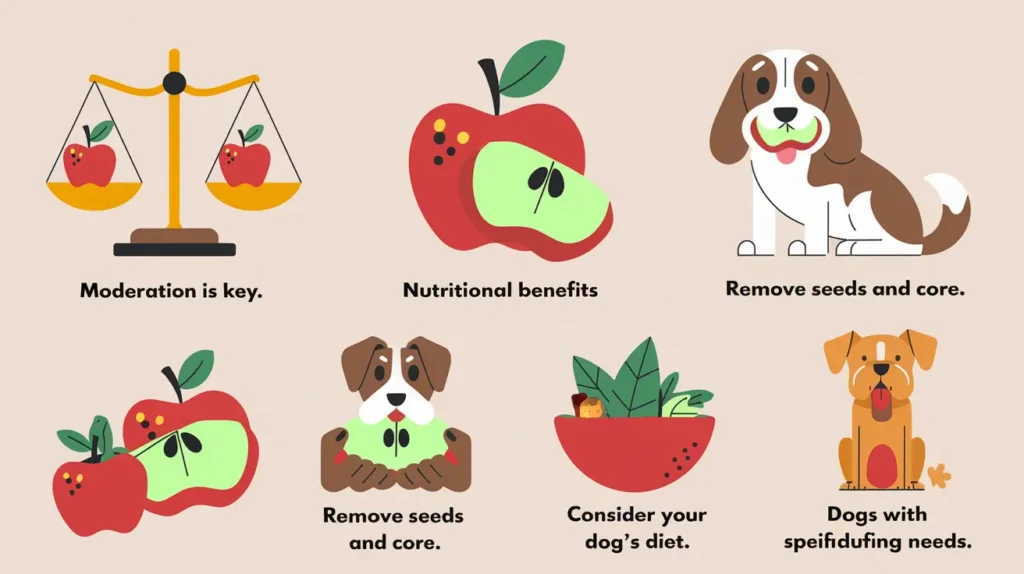
4. Consider Your Dog’s Diet: Apples should be treated as a supplement to your dog’s regular diet, not a replacement. Dogs need a balanced diet of protein, fat, and carbohydrates, and apples should be given as an occasional treat rather than a daily staple.
5. Dogs with Special Dietary Needs: If your dog has diabetes or other health conditions, it’s important to consult with a veterinarian before giving them apples every day, as the fruit’s natural sugars can impact their blood sugar levels.
Conclusion
Apples can be a delightful and nutritious treat for dogs when served in moderation. Packed with essential vitamins, fiber, and antioxidants, apples can complement your dog’s diet and support their overall health. Remember to follow safety guidelines, including removing the seeds and core, to prevent any health issues. By offering this refreshing fruit responsibly, you can enhance your dog’s diet while ensuring their safety.
For more healthy feeding tips and ways to keep your dog in peak health, remember to consult with your veterinarian.
Frequently Asked Questions About Dogs and Apples
1. Can Puppies Eat Apples?
Yes, puppies can enjoy apples, but in moderation. Since puppies have sensitive digestive systems, introduce apples in small amounts to prevent any digestive discomfort.
2. Are Green Apples Safe for Dogs?
Green apples, such as Granny Smith, are safe for dogs. They are often less sweet than red apples and provide the same nutritional benefits. However, the tartness might not appeal to all dogs, so observe your dog’s reaction.
3. Can Dogs Eat Cooked Apples?
Yes, cooked apples without any added sugar or seasoning can be safe for dogs. Avoid feeding apple pie or any dessert containing sugar, butter, or spices, as these ingredients can be harmful.
4. What to Do If Your Dog Eats Too Many Apples?
If your dog consumes a large quantity of apples, they may experience symptoms like vomiting, diarrhea, or abdominal discomfort. Monitor for these signs and consult a veterinarian if symptoms persist.
5. Can Dogs Have Apple Juice or Applesauce?
Apple juice and applesauce are not recommended for dogs, as they often contain added sugars and preservatives that can lead to weight gain and other health issues. If you want to give applesauce, make sure it’s unsweetened and only offer small amounts.







